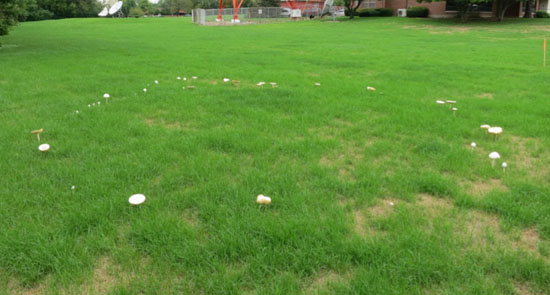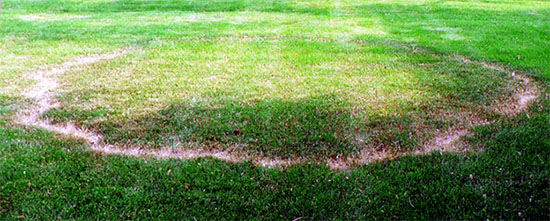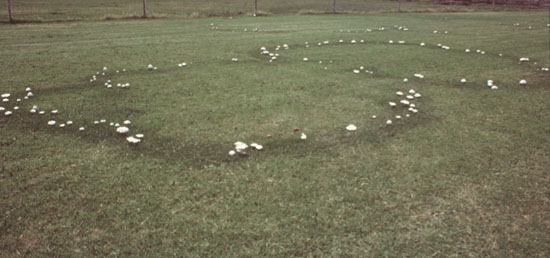Issue 16, September 10, 2012
Fairy Rings on Turf
Heavy rains over the past week have promoted the growth of mushrooms in landscapes across Illinois. On turf, mushrooms can form in distinct circles or arcs, a condition referred to as "fairy rings." Fairy rings obtained their name from old folklore that theorized the rings to be areas where elves, pixies, or fairies danced and played.

Type 3 fairy ring displaying only a visible ring of mushrooms
Three types of fairy rings appear on turf. The diameter of the rings can range from a few inches to 50 feet or more in diameter. The rings reappear from year to year and continue to widen as the fungus expands below ground.
Type 1 fairy rings appear as ringed areas or brown, dead or dormant grass. The dead or dormant grass is likely caused by the dense subsurface layer of fungal growth that creates a hydrophobic soil condition and impedes water movement in to the soil. Some other theories suggest the subsurface fungal growth depletes nutrients essential for plant growth, and may even produce toxic levels of ammonia or hydrogen cyanide that kill the grass. Type 1 fairy rings commonly occur with an area of lush dark-green growth bordering the outer margin of the killed/dormant ring. The lush, dark-green grass of the fairy ring is the result of an increased amount of nitrogen made available to the grass by the fungus as it breaks down organic matter in the thatch and soil. Mushrooms may or may not appear with a type 1 fairy ring.

Type 1 Fairy Ring with dead/dormant turf. Photo credit: James Schuster
Type 2 fairy rings appear as circles or arcs or lush dark green growth. As with a type 1 fairy ring, the lush growth is also the result of increased available nitrogen produced as the fungus breaks down organic matter. Type 2 fairy rings may appear with or without mushrooms present. This type of fairy ring does not result in dead or dormant turf.

Type 2 fairy rings with lush dark green circles and mushrooms. Photo Credit: Dr. Bruce Branham
Type 3 fairy rings appear as circles or arcs of mushrooms with no visible effect on the turf (first image).
Of the three types of fairy rings, the type 1 ring is the most unsightly and difficult to control. The soil in the affected area can become almost impervious to water. Areas of killed turf are difficult to re-establish and are often invaded by weeds. Fungicide applications have provided mixed results in suppressing fairy ring development. The fungicides need to be applied with a soil surfactant at a time when the fungus is actively growing. Symptoms can be "masked" by deep watering. Core aerification and the use of wetting agents will help the water move deeper into the soil.
Type 2 and type 3 fairy rings are easier to mask. Fertilizing the areas around a type 2 fairy ring will promote lush green growth of the turf surrounding the ring. The fairy ring will essentially blend in with the fertilized turf. Mushrooms with associated with the fairy rings can be removed by mowing or raking. Neither of these methods will suppress nor weaken fairy ring fungus. However, they are cost effective and will reduce the aesthetic damage caused by the fairy ring. Other control techniques, such as soil excavation and fumigation are expensive, labor intensive, and usually cost prohibitive.
Site conditions that promote fairy ring fungi can be avoided. Before planting a new turf area, remove tree stumps and large roots, construction lumber, and other large pieces of organic matter from which these fungi obtain nutrients. (Travis Cleveland)
Author:
Travis Cleveland